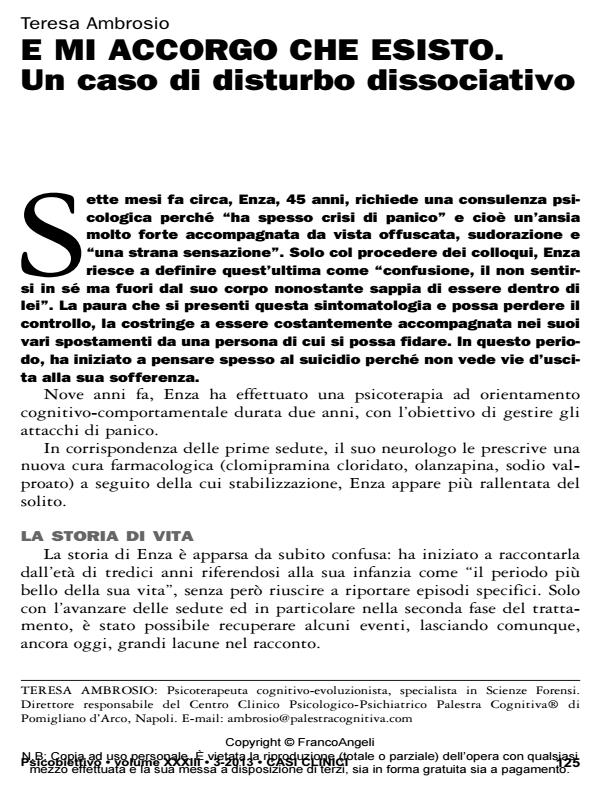So i feel i exist. A case of dissociative disorder
Journal title PSICOBIETTIVO
Author/s Teresa Ambrosio
Publishing Year 2014 Issue 2013/3 Language Italian
Pages 11 P. 125-135 File size 315 KB
DOI 10.3280/PSOB2013-003007
DOI is like a bar code for intellectual property: to have more infomation
click here
Below, you can see the article first page
If you want to buy this article in PDF format, you can do it, following the instructions to buy download credits

FrancoAngeli is member of Publishers International Linking Association, Inc (PILA), a not-for-profit association which run the CrossRef service enabling links to and from online scholarly content.
The author illustrates the clinic case of Enza, a patient with a Dissociative Disorder. In the first part, the case is based on her life story, on the disorder description, on the reasons of the decompensation, on the mechanisms of maintenance and on the patient’s vulnerability. In the second part, the cognitive-evolutionary psychotherapic treatment as yet effected is described in its specific phases. Later, the problematic moment and the difficulties of the case are described.
Keywords: Dissociation; Depersonalization; Identity; Complex Post-Traumatic Stress Disorder; Trauma.
- American Psychiatric Association (APA) (2002) Manuale diagnostico e statistico dei disturbi mentali. DSM IV-TR, Masson, Milano
- Bermudes R.A., Wright J.H., Casey D. (2010) “Tecniche della terapia cognitivo-comportamentale”, in Gabbard G.O. (a cura di), Le psicoterapie, Raffaello Cortina, Milano pp. 221-256
- Chu J.A. (1998) Rebuilding shattered lives: the responsible treatment of complex posttraumatic and dissociative disorders, Wiley, New York
- Fonagy P., Target M. (1991) Attaccamento e funzione riflessiva, Raffaello Cortina, Milano
- International Society for the Study of Dissociation (ISST-D) (2000) “Guidelines for the treatment of dissociative identity disorder in adults”, Journal of Trauma and Dissociation, 6: 69-149
- Lieberman M.D., Eisenberger N.I., Crockett M.J., Tom S.M., Pfeifer J.H., Way B.M. (2007) “Putting feelings into words: affect labeling disrupts amygdala activity in response to affective stimuli”, Psychological Science, 18: 421-428 Liotti G., Farina B. (2011) Sviluppi traumatici. Eziopatogenesi, clinica e terapia della dimensione dissociativa, Raffaello Cortina, Milano
- Miti G., Onofri A. (2011) “La psicoterapia dei disturbi dissociativi: dalle tecniche cognitivo-comportamentali all’approccio EMDR”, Cognitivismo Clinico, 8, 1: 73-91
- Perdighe C., Mancini F. (a cura di) (2008) Elementi di psicoterapia cognitiva, Giovanni Fioriti, Roma
- Van der Kolk B., Pelcovitz D., Roth S., Mandel F.S., Mcfarlane A., Herman J.L. (1996) “Dissociation, somatization, and affect disregulation: the complexity of adaptation to trauma”, American Journal of Psychiatry, 153: 83-93
Teresa Ambrosio, E mi accorgo che esisto. Un caso di disturbo dissociativo in "PSICOBIETTIVO" 3/2013, pp 125-135, DOI: 10.3280/PSOB2013-003007